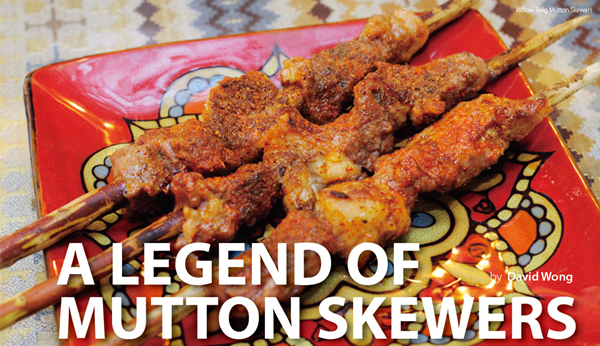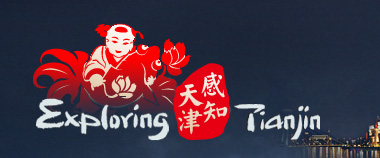
Xinjiang is featured in our Travel article in this month's issue. It is truly an interesting part of China and very different in culture and cuisine. In recent years, Xinjiang food and has started to become available in other parts of China. In Tianjin, there are dozens of restaurants featuring Xinjiang dishes. Xinjiang Cuisine has also made its way to the west. The Herembag Xinjiang chain is found throughout China and recently opened a branch in San Francisco.
The main foods used in this cuisine are: roasted mutton, kabobs, beef, and roasted fish, rice and naan bread. For flavoring the food, spices include: cumin seeds, red pepper flakes, salt and black pepper. Raisins are abundant in the region and used often in their cooking.
Signature dishes
Kababs (spelled Kabob in the west) Chuanr 串
The most commonly recognized Xinjiang food has to be the “Kabab” or Chuanr in Chinese, the Chinese character even looks like it 串. These are bits of mutton stabbed by skewers, sprinkled liberally with spices of cumin, pepper flacks, salt and pepper and barbecued over hot coals or an electric grill. In recent years, the charcoal has been replaced by electric grills due to pollution concerns but hasn’t affected the popularity of this dish.
Da Pan Ji 大盘鸡 Big Plate Chicken
Is a whole chicken stewed in a large pan with spices. After the meat is eaten, noodles are cooked in the remaining broth and carcass to absorb all the flavors.
The Naan bread from this region is similar to the Indian variety cooked in a tandoor oven but is crispier and cooked with the same cumin spices and salt and pepper. It goes well with the dishes mentioned above. You can see these pizza-shaped breads dried and piled up high in markets but taste great after being steamed or heated up.
Staple Foods
ShouLa Mian手拉面 (Hand Pulled Noodles)
This is very similar to the Chinese dish using noodles that are also hand pulled but the Xinjiang dish is prepared in the Uygur fashion and has a distinctive flavor. It can be served in a soup, commonly mutton or beef or served fried with vegetables and meat called “Dry Fried Noodles” 干炒面 “Gan Chau Mian”. Not really completely dry but has a moist sauce rich in flavors of tomatoes, peppers and onions. Both are very good “comfort foods” when you want to feed that carbohydrate fix.
Polu or Pilaf Rice, 抓饭 Zhua Fan
Another typical Uygur dish is Polu or Pilaf, in Chinese it is call Zhua Fan抓饭, it literally means “Grabbed Rice” because the traditional way of eating this is by hand. It is a rice dish made by first frying mutton or chicken with carrots then adding onions and oil and spices. The rice is added at the end and steamed with raisins or dried apricots.
Shorpa (Chorba) 汤饭 Lamb Soup and Rice
This soup or stew originates from Persia or what is now Iran. The main ingredient is lamb or mutton and the soup is boiled for several hours with the meat on bone, vegetables such as carrots, tomatoes and potatoes are added. Some recipes call for grains such as barley and rice. What you end up with is a rich broth and stew, which is a meal by itself. (Lamb is a young sheep, mutton is meat from a full-grown sheep and the term can also be used for goats; much of the mutton in China is what we refer to as goat)
Snacks Sangza 馓子 San Zi is a popular Xinjiang snack consisting of deep-fried noodles in a twisted pyramid shape. The snack is made by pulling wheat flour dough into thin strips, which are deep-fried. Bunches of the strips are then shaped into rings, which are stacked into a pyramid.
Kao Bao Zi 烤包子Baked Buns are like very large dumplings stuffed with mutton and veggies, usually carrots. They are traditionally baked in an oven just like a Tandoori oven. They make a rich snack but probably high in cholesterol so try to stop at a couple.
Beverages
There is a Xinjiang Black Beer that is available in some Xinjiang restaurants; it has a much heavier taste than local beers. Since grapes are in abundance in the area, there are several Xinjiang wines; most are a newer vintage and lighter in taste. Chinese style teas are very prevalent, although the region not known as a tea producing area. If you really want to go local they have a ceremonial drink made from Horse Milk, but I suggest you pass on this one, it has a taste that only a local could accept.
Desserts
The most famous dessert is probably Uygur Nut Cake 切糕 “Qie Gao” or Walnut Cake 核桃糕 “He Tao Gao”. You have probably seen these available on the street on the back of a 3-wheel bike. It’s a massive cake about 6 inches high made of flour, nuts and dried fruits. If you want a piece, the vendor will cut off a piece with a huge knife but you had better confirm a price before committing.
Another favorite is their yogurts or called “Sour Milk” 酸奶 “Suan Nai” these are usually made in the texture of a jello and not sweet but a refreshing taste. Some will add some raisins and cooked rice, very similar to our rice pudding.
Fruits and Nuts
Probably because the climate of Xinjiang, extreme warm and cold, the land produces very good fruit and nuts. One of these are the Hami Melon 哈密瓜 which originates from a Hami city in Xinjiang. It is similar to a cantaloupe but shaped more like a larger rugby ball and very tasty when ripe.
The red jujube 红枣 Hong Zao is probably the largest and best from this region. As mentioned before, grapes are everywhere and if you visit in the summer and early autumn, you will see rows of brick huts drying them into raisins. The dry desert-like climate makes it ideal to preserve the fruit.
Walnuts 核桃 HeTao, Almonds杏仁 XingRen, Cashews腰果 YaoGuo and Filberts 榛子 Zhenzi are to name a few of the most popular nuts that find their way to the Tianjin markets.
Conclusion
As you can see Xinjiang may be thousands of kilometers away but the cuisine has certainly become popular lately and if you use the Jin Advisor app, you can find many options to enjoy this very unique adventure in food.

 Daily life
Daily life




